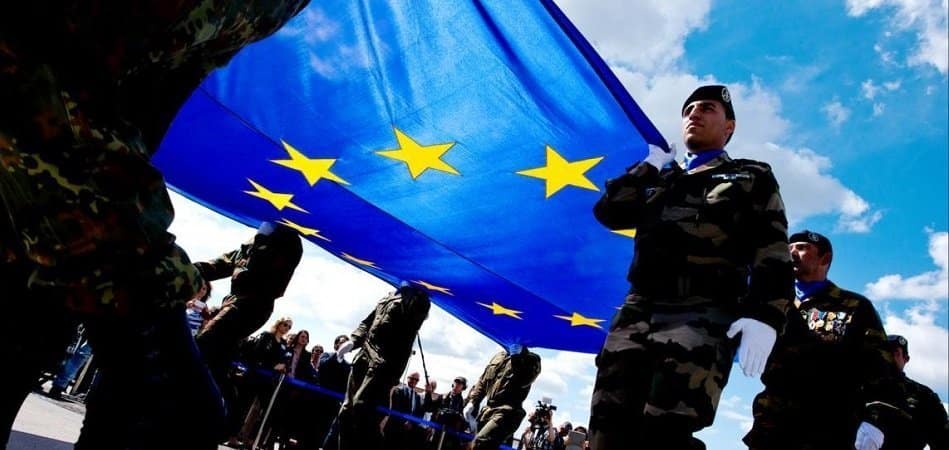Due to the popularity of our recent report on AI at the top 5 US defense contractors, we decided to broaden our scope of AI in the world’s militaries. This report attempts to illuminate the current artificial intelligence projects at Europe’s largest private defense contractors.
Militaries around the world are starting to take interest in artificial intelligence. Defense contractors are attempting to fill that demand by solving new problems with artificial intelligence.
The United States’ Department of Defense spending is that of the next largest seven militaries in the world. It follows that there are more than just American companies that hold contracts with the DoD. There is still a large opportunity to be won for European defense contractors attempting to deal with the United States. European militaries are of course also prime contracting opportunities for European defense and security companies.
Of the applications covered in this report, the most impactful may be the Intelligence Engine rolled out by Rolls Royce. The Intelligent Engine is a jet turbine equipped with artificial intelligence designed to predict and alert operators of needed maintenance, as well as potential changes to flight plans and flight operations. Intelligent Engine has both commercial and military applications. Delays due to maintenance can jeopardize critical military operations and potentially put lives at risk.
This report on the military applications of AI at 4 of Europe’s large military defense contractors covers the following four applications:
- Airbus Defense and Space – OneAtlas, a software for removing clouds and weather effects from satellite images
- Thales – RAPIDFire, an autonomous turret
- Leonardo – HERO, a semi-autonomous rotary unmanned aerial vehicle
- Rolls Royce – Intelligent Engine, a predictive maintenance software
This report is intended to show the various capabilities currently in the works at European defense contractors; those very same companies are likely to have additional machine learning technologies they are currently working on given their research and development budgets.
Airbus Defense and Space
Airbus Defense and Space is a subsidiary of Airbus, an aeronautics company in the Netherlands established in 1970. Today, Airbus Defense and Space generates $10.8 billion in revenue, 21% of Airbus’s total reported revenue of $66 billion for 2017. Airbus Defense and Space offers militaries and companies a software called OneAtlas, which it claims delivers high resolution, up-to-date satellite imaging of the globe using machine vision. The software can purportedly remove clouds and weather effects from satellite images.
We can infer the machine learning model behind the software was trained on thousands of satellite images showing all areas of the globe from various angles, in various weather conditions, and at various times. The images containing weather effects would have been labeled by Airbus analysts as obscured.
The photo would then have been digitally enhanced to not include the seasonal effect and then labeled again, perhaps as an enhanced image. These labeled images would then be run through the software’s machine learning algorithm.
This would have trained the algorithm to discern what clouds in a satellite image might be obscuring. When the software captures satellite images, it could then remove clouds and weather effects automatically.
Paul Eremenko was the CTO at Airbus from 2015 to late 2017, and he is currently the CTO of Unitec Technologies. He holds an MS in Aeronautics from the California Institute of Technology. Eremenko also spent some time heading Google’s Project Ara. In addition, he was the Deputy Director and Acting Director of the Tactical Technology Office at DARPA, the research and development organization of the US Department of Defense. Paul was followed by Grazai Vittadini in the CTO position; she has served 17 years at Airbus in various engineering design roles.
Leonardo
Leonardo is an Italian aerospace, defense, and security company with 20,000 employees. The company was selected to head the European Union’s defense fund, OCEAN2020, a program designed to integrate unmanned craft of different types (fixed wing, rotary wing, surface, and underwater) with naval units’ command and control centers, allowing for improved data exchange via satellite.
Below is a short 2-minute video demonstrating HERO in flight and Leonardo’s design intent with the RUAV:
Leonardo offers a semi-autonomous craft called the HERO RUAV (Rotary Unmanned Aerial Vehicle), which it claims can help maintain short flight naval surveillance at a reduced operational cost. Although intended to operate via controls aboard an aircraft, HERO can autonomously take off, land, follow “return home” protocols, and follow “connection lost” protocols.
The types of technologies used in implementing artificial intelligence for autonomous vehicles are a combination of mechanical devices for physical vehicle operations, navigational instruments, and machine vision. Boeing’s AI applications are in large part autonomous vehicles.
Machine vision software is trained by numerous mounted cameras all around the autonomous vehicle at various heights and angles that allow it to detect how the craft is moving from every perspective. The software first is trained on hundreds of hours of human operating footage showing the proper and safe way a vehicle should operate at various times of day and in various weather conditions.
Leonardo claims HERO is equipped with crash and collision avoidance AI, meaning the vehicle is programmed to make vertical navigation adjustments to avoid a crash it can anticipate.
As the ninth largest military defense contractor in the world, with $11.5 billion in total revenue, Leonardo claims a number of marquee clients. The US Navy contracts with Leonardo on numerous vehicle contracts. Leonardo’s approval to head OCEAN2020 could also indicate a commitment to further advancing AI in the military in the coming years.
Jason Cowell is CTO for the Electronic Warfare business within the Airborne and Space Systems Division at Leonardo. We can infer he was at least partially responsible for a portion of the HERO RUAV development. He holds a PhD in Physics from Oxford University.
Thales
Thales is a French defense contractor partially owned by the French Department of Defense. Thales generated roughly $18 billion in revenue in 2017.
Thales offers a weapons platform for fixed point defense called RAPIDFire, which it claims utilizes target recognition software to govern airspace and appropriately determine whether or not a target is hostile using machine vision. Once a target is acquired, the craft operator must approve any discharge of defensive ordnance. Thales claims there is also an option for RAPIDFire to operate fully autonomously. RAPIDFire is equipped with 6 short-range anti-aircraft missiles and a 40mm cannon.
Below is a short 3-minute video demonstrating and highlighting RAPIDFire’s targeting capabilities:
We can infer RAPIDFire’s autonomous targeting system utilizes machine learning. The machine learning model behind the software was trained on thousands of hours of moving target footage from various angles and in various lighting and weather conditions. This footage would have been labeled as a military target, such as an aircraft, human operator, helicopter or truck.
This labeled footage would then be run through the software’s machine learning algorithm. This would have trained the algorithm to discern the sequences and patterns of 1’s and 0’s that, to the human eye, form the video of an enemy aircraft or ground transport as displayed on a video monitor.
The user could then upload additional footage with potential military targets that are not labeled into its software. The algorithm behind the software would then be able to recognize the shape of something in the footage that appears to be a military target. The system could then alert a human operator and awaits input on if the potential target is hostile or not.
John Best is CTO at Thales. He holds a PhD in Mathematics from the University of Wollongong. John joined Thales following a 15 year career with the Defence Science and Technology Organisation of Australia, during which he contributed to, and led, programs of work including underwater weapon effect modeling, mine warfare operations research, synthetic environments, and naval combat systems.
Rolls Royce – Intelligent Engine
Rolls Royce Motors is the second largest manufacturer of aerospace propulsion systems in the World and the 16th largest defense contractor in the world. Although Rolls Royce is popularly associated with luxury cars, that portion of the company is owned and operated by BMW. Rolls Royce Motors, however, offers to military and commercial organizations alike the Intelligent Engine. They claim it is an autonomous, AI-powered, engine able to communicate to the engine’s operator, air traffic controllers and a network of other Intelligent Engines in real time. Rolls Royce Motors claims Intelligent Engines is able to suggest and predict needed engine maintenance, flight corrections and piloting maneuvering suggestions.
Below is a short 3-minute video demonstrating how Intelligent Engine works:
Rolls Royce suggests the sensors within their engines would collect telemetric data for the engine, such as the amount of dirt and build-up within the turbine casings. This data would then be used as a baseline for a properly functioning engine turbine.
The machine learning model behind the software would need to be trained on millions of these telemetric data points and data about when certain parts of the turbine required maintenance, how long maintenance on those parts took, and possibly how long replacement parts took to arrive on site. The data would then be run through the software’s machine learning algorithm. This would train the algorithm to discern which of all these data points correlate to properly functioning turbine parts, the time at which the turbine has needed maintenance in the past, and which of its parts needed repair.
The software would then be able to predict when certain parts of their fleet of jets and their associated turbine engines are due for maintenance before they break down.
Paul Stein is the Director of Research and Technology at Rolls Royce. Paul graduated in Electrical and Electronic Engineering from King’s College London in 1978. He is a Fellow of the Royal Academy of Engineering, a Fellow of the Royal Aeronautical Society and a Fellow of the Institution of Engineering and Technology. Previously, he served as Rolls Royce’s Chief Scientist.
Header Image Credit: Strategic Culture Foundation


















